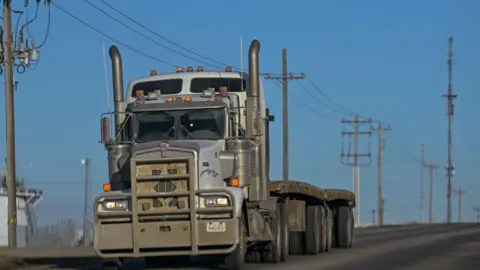The trucking industry, historically one of the most vital components of the global economy, is currently grappling with the challenges and opportunities presented by new technology. As highlighted in an article by Sam Gruet, the intersection of digital innovation and trucking poses both advancements and drawbacks, revealing a complex relationship between traditional practices and modern technological solutions.
Jared, a Canadian truck driver, reflects on his two-decade career, which has drastically transformed due to digital technologies. Initially accustomed to cumbersome methods, such as relying on payphones and pagers to secure work, he now utilizes a myriad of devices including laptops, tablets, and smartphones to streamline his tasks. The rise of “Uberized” platforms has enabled greater efficiency in matching trucks with clients seeking to transport goods; however, this convenience comes at a cost. Jared states that while securing jobs is easier than ever, the monetary remuneration has suffered. Pre-COVID distances yielded an average of $3 per mile, whereas current figures show that some routes, like Toronto to Los Angeles, have plummeted to $1.10 per mile. This drastic reduction is compounded by soaring fuel prices, further straining the financial landscape for many drivers.
In the face of such challenges, significant players in the Canadian freight industry, such as Uber Freight, are capitalizing on a marketplace increasingly reliant on technology. With over 80% of trucking and freight firms in Canada employing fewer than five people, these platforms are filling a gap in a fragmented market. Nevertheless, Christopher Monette from Teamsters Canada expresses concern regarding the “Uberification” of the trucking sector, which he believes undermines labor standards and workers’ rights. He emphasizes the need for more robust protections and fairer wages rather than merely adopting technological tools that may exacerbate existing issues.
On the other side of the spectrum, companies like Vancouver-based Freightera are innovating the digital trucking landscape in ways that aim to benefit drivers rather than exploit them. Founder Eric Beckwitt underlines that their platform allows carriers to set their own prices based on what they believe is necessary to remain profitable. Unlike some of their competitors, Freightera does not dictate price levels but instead seeks to provide a reliable market for drivers to work in. Beckwitt highlights the potential of artificial intelligence to alleviate the complexities of logistics and bookings, enabling freight owners to navigate obstacles, paperwork, and unexpected charges with greater efficiency.
Globally, the trend of digitizing truck services is not limited to Canada. In countries such as Kenya, the logistics sector is embracing modern technology as a solution to longstanding inefficiencies. With over 75% of inland freight transported via road, platforms like LORI have arisen, connecting 20,000 trucks and ensuring better route utilization. The platform operates on a digital management model that keeps trucks moving to minimize idle time and ensure efficiency.
However, as the industry shifts towards embracing new technological advancements, there is an inherent concern about the future role of truck drivers. The emergence of autonomous driving technology is a double-edged sword. While it could streamline operations and possibly alleviate the shortage of drivers, it poses a looming threat to job security. In recent months, autonomous trucks have begun trial runs; yet the widespread acceptance of this technology remains uncertain. Many in the industry, including veteran operators like Jared, feel that the personal touch and adaptability of human drivers cannot be easily replaced.
The evolving landscape of the trucking industry underscores the necessity of balancing innovation with labor rights and wage equity. While technological advancements hold the promise of enhanced efficiency and reduced emissions, they also demand careful consideration of their socio-economic impact on those who rely on trucking as their primary means of income. As the journey towards modernization continues, the industry must navigate its path with mindfulness, ensuring that both technological progress and worker welfare go hand in hand.











